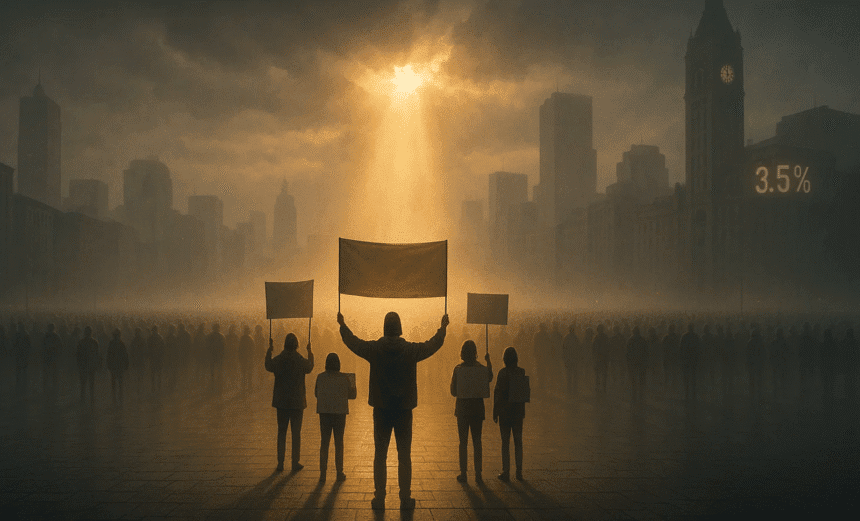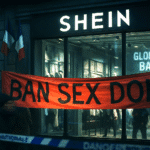In recent years, a small but powerful figure, 3.5%, has gained remarkable attention among protest movements worldwide. Known as the “3.5% rule,” this concept suggests that when about 3.5% of a nation’s population actively participates in sustained, non-violent protest, the chances of achieving major political or social change rise dramatically. The idea is rooted in research conducted by political scientists Erica Chenoweth and Maria J. Stephan, who studied 323 violent and non-violent resistance campaigns between 1900 and 2006. Their findings, published in the 2011 book Why Civil Resistance Works: The Strategic Logic of Nonviolent Conflict, revealed that non-violent movements were roughly twice as successful as violent ones and that all movements that had mobilized at least 3.5% of the population ultimately succeeded.
The origins of this rule can be traced back to the early 21st century, when Chenoweth and Stephan analyzed data from over a century of political struggles. They discovered a striking pattern: movements that remained non-violent and managed to involve at least 3.5% of citizens at their peak almost always achieved their goals. This statistic has since been popularized in academic circles, activism, and even mainstream media through Chenoweth’s TEDx talks and subsequent analyses. The figure, however, should not be seen as a magical threshold or a mathematical law; it is more of an empirical observation about the tipping point where public dissent becomes too widespread for authorities to ignore or suppress effectively.
The reasoning behind the 3.5% figure is both strategic and psychological. When a movement engages this level of participation, it reflects a cross-section of society large enough to disrupt normal political and economic functions. At that scale, governments often face pressure not only from the streets but also from within their own institutions, as elites and security forces begin to defect or call for reform. Crucially, Chenoweth’s research showed that non-violent movements such as strikes, boycotts, and sit-ins tend to attract broader participation than violent uprisings, since ordinary people are more willing to join peaceful demonstrations. This inclusivity creates moral legitimacy and social power that can lead to negotiation or transformation without bloodshed.
It’s important to clarify that the 3.5% rule is not a legal concept but an analytical one. No law recognizes or enforces this threshold. Instead, it has become a motivational benchmark for activists. Movements like Extinction Rebellion and other pro-democracy or climate campaigns have invoked the rule as an aspirational goal, seeking to mobilize 3.5% of their countries’ populations. For instance, in the United States, that would mean about 12 million active participants, a formidable number, but theoretically achievable. Yet, even Erica Chenoweth has cautioned against interpreting the rule too literally. It describes what has happened historically, not what will inevitably happen in the future. Context matters: movements succeed not simply because of their size, but because of their strategy, unity, and ability to sustain non-violent discipline.
Legal scholars and political observers have also pointed out that while the 3.5% benchmark worked historically for regime changes or revolutionary struggles, its application to modern democracies is more complex. Protests in established democratic systems may aim for policy reforms rather than overthrowing governments, meaning that smaller or differently structured movements can still be effective. Moreover, modern states have become more adept at controlling or fragmenting dissent through digital surveillance, disinformation, and targeted policing, complicating the once-clear relationship between participation and success.
Nevertheless, the appeal of the 3.5% rule endures because it offers hope and direction. It suggests that even a relatively small, dedicated minority can shift the political balance if they act strategically and peacefully. It’s a powerful counterpoint to apathy, emphasizing that mass participation, even short of a majority, can yield transformative results. Historical examples include the 1986 “People Power” movement in the Philippines, the Velvet Revolution in Czechoslovakia, and Lebanon’s 2005 Cedar Revolution, all non-violent campaigns that mobilized roughly that critical percentage of their populations to achieve change.
In today’s climate of social unrest, from environmental activism to democracy protests, the 3.5% rule continues to resonate as both a research insight and a rallying cry. While it should not be viewed as a formula for guaranteed success, it underscores a vital truth: the power of collective, peaceful action can be far greater than its size suggests. The lesson is simple but profound: change does not require everyone, but it does require enough people willing to stand together and stay committed.



















